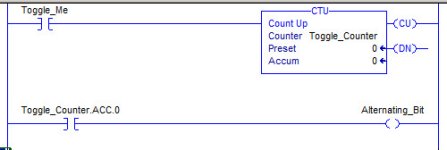One simple way to do this is to use a one-shot and an add instruction to add 1 to an integer. Whenever you add 1 to a number, the last bit of that integer will alternate. Therefore, you can use the last bit of that integer to control your pumps.
If you are worried about an overflow, move 0 into the value when it is an even number. If you wish to bypass the alternator because one of the pumps is faulted, you can just move a 0 or 1 into the integer depending on which pump you want to run.
If you are worried about an overflow, move 0 into the value when it is an even number. If you wish to bypass the alternator because one of the pumps is faulted, you can just move a 0 or 1 into the integer depending on which pump you want to run.






